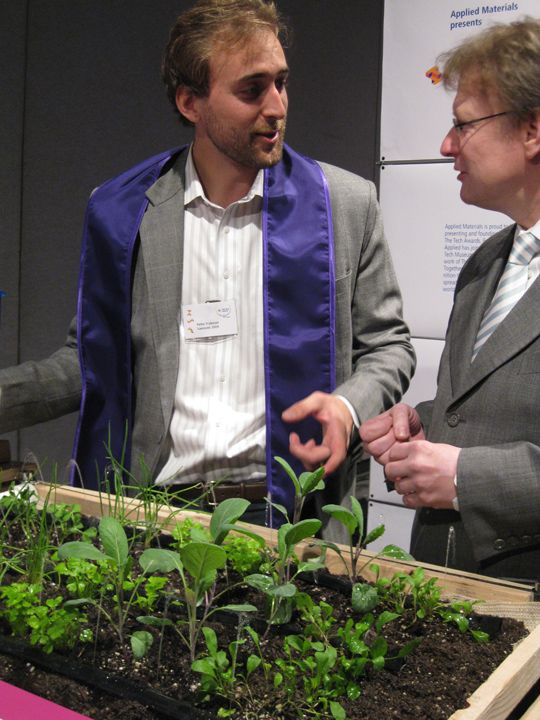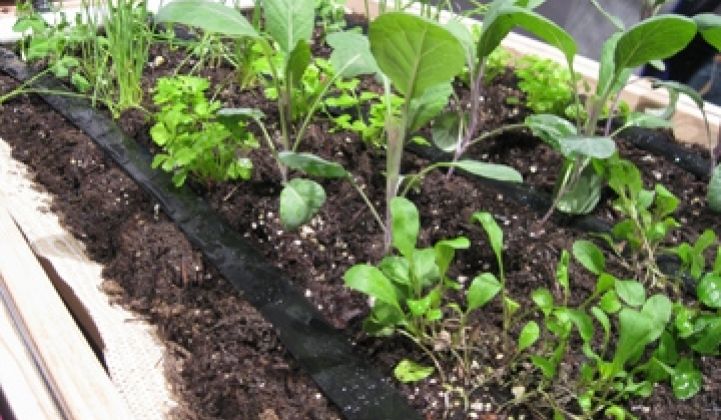They brought cheap irrigation systems to small farmers, solar charged lanterns to flood-prone communities and zinc-air fuel cells to poor neighborhoods.
These entrepreneurs are among those honored at the Tech Awards in San Jose, Calif. Thursday, an even that highlighted innovations developed with humanitarian aid in mind. Many of them run for-profit businesses, but all of them have figured out ways to serve people in low-income, resource-poor corners of the world.
Here are some of the greentech-for-good enterprises:
A Lifeline For Small Farms: Driptech in Palo Alto, Calif., began with an idea conceived by three graduate students at Stanford University during a 2008 trip to Ethiopia, where they saw farmers struggling in the worst drought in 20 years. They returned to school and designed a drip irrigation system for small farms that is cheap to make, easy to maintain and use water efficiently, said Peter Frykman, who has since graduated and serves as the company's CEO.
The core technology is the plastic tubing hole-punched by laser to dispense water. The tubing is made with low-density polyethylene. The tubes are connected to a PVC pipe which, in turn, is hooked up to a water tank that uses gravity to pipe water to the field. The system conserves water use and allows farmers to crow crops during dry season.
Frykman said many other commercial drip-irrigation systems are not so affordable because they use high-pressure pumps and filters.
The farmers would have to bring their own oil drums or other containers for water storage. Driptech would retrofit the drum, provide other equipment and set the whole system. A family could get a system set up for $30. It would cost $300 for a 1-acre farm.
Driptech completed a pilot project in India and just inked a deal with its first commercial customer, the Lingqiu County government in China. The county is buying the equipment for 200 farmers.
Frykman started the business with $100,000 in grants, donations and angel funding. He hopes to raise a few hundred-thousand dollars to boost the company's manufacturing operation.

Peter Frykman, CEO of Driptech pictured at left.
Solar Lighting and Mobile Library: Every year, floods and hurricanes cut off road access for many residents in north western Bangladesh and turn some of them into transients as they wait for the water to subside.
Shidhulai Swanirvar Sangstha is a nonprofit that brings library, healthcare, job training and other services via a fleet of 54 boats. It designed and began distributing solar lanterns in 2008 to bring much-needed electricity and job opportunities to the area.
The group retrofits kerosene lanterns with a 5-watt CFL bulb and two 6-volt batteries. It also operates mobile, solar-powered charging stations (on boats) for people who need to refill their batteries. Shidhulai has been buying crystalline silicon solar panels that are mostly made by Kyocera in Japan.
The nonprofit charges $4.35 for each retrofit and 7 cents for each recharging, which is good for providing four to five hours for three nights, said Mohammed Rezwan, who founded the nonprofit in 1998.
"We are targeting landless people to provide light and improve their livelihood," Rezwan said.
Some of the lanterns, which are called SuryaHurricane, come with little solar panels that the size of a magazine. Shidhulai, which gets funding from corporations and foundations, has outfitted 600 lanterns since last year, and expects that number to reach 1,000 by the end of this year.
Zinc for Light and Garden: Rolf Papdorf has turned a technology more than a century old into a portable source of power and plant nutrients for his native South Africa.
His company, Alternative Energy Development Corp., makes zinc-air fuel cells, and recycles the byproduct, zinc oxide, for fertilizer. AEDC developed the fuel cell pack to serve low-income residents, many of them still rely on candles for light, Papdorf said.
For $250, you get a case with 11 fuel cell packs and related equipment for charging cell phones and powering other electronics. It would cost $8 to replace the fuel cells, he said. Each case could produce 4,000 watt hours of electricity, enough to last a month if residents only need electricity for four to five hours a day to run lights, a radio and small TV, Papdorf said.
AEDC has found customers in mining companies that are required by law to invest in social projects for their local communities. The fuel cells not only provide lighting, but could also provide a source of income for those running mobile phone charging or printing services, for example.
"It's plug and play, and you can get clean energy," Papdorf said.
Hearing Aided by the Sun: Howard Weinstein designed a solar powered hearing aid back when he was a Peace Corps. volunteer in Bostwana in 2002. The idea was to make inexpensive hearing aids while also providing jobs to local deaf people. His hard work paid off, and he was later invited to do the same in Brazil
Weinstein said rechargeable, nickel metal hydride batteries weren't available before he designed Solar Ear. The hearing aid, which comes with a charger embedded with crystalline silicon solar cells from Taiwan, costs $100. Each rechargeable battery goes for $1. Without using the rechargeable batteries, each hearing aid owner could end up tossing away $70 worth of batteries each year. "It's a waste," he said.
Weinstein is taking his program to Palestine, where he will hire Palestinian and Israeli deaf workers to produce and sell Solar Ear. He calls it a peace mission, hoping his project would help to foster good relations between the two cultures.
Setting up such a manufacturing and job training operation would cost about $300,000, Weinstein said. Aside from revenues from the sales, the program gets funding from nonprofit organizations such as the Lemelson Foundation in Portland, Ore. Solar Ear is available in 31 countries.
Photo: A Driptech irrigation system.



